The Arnold Schönberg collection
“Quite certainly the radio is a foe! – and so are the gramophone and soundfilm. An inexorable foe, irresistibly on the advance; opposition is a hopeless prospect. Here are the most damaging things it does: […] It accustoms the ear to an unspeakable coarse tone, and to a body of sound constituted in a soupy, blurred way, which precludes all finer differentiation.”
(Arnold Schönberg: Reply to a Questionnaire, 1930)
Arnold Schönberg was critical of the phonograph disc. When this medium began to enjoy widespread success in the 1890s, he had already gained a broad knowledge of the repertoire by studying scores and playing music with friends. Sound storage media were not only a prohibitively expensive luxury, they were rather uninteresting for accomplished musicians owing to their considerable technical limitations. Schönberg’s daughter Nuria remembers that the composer hardly used the gramophone, even in later years while in the United States.
“Mostly, we listened to the radio program that broadcast classical music every evening from 8–10 p.m. One of my happiest memories is listening to the radio and looking over my father’s shoulder as he followed the music in the score.”
The disadvantages of the phonograph disc were evident: the earliest recording of a work by the composer, his tone poem Transfigured Night, op. 4 for string sextet, was released in 1925 on seven sides of discs. Besides the continual interruptions in the musical flow, the sound quality was only moderate, and compromises had to be made particularly in the case of works with rich orchestration.
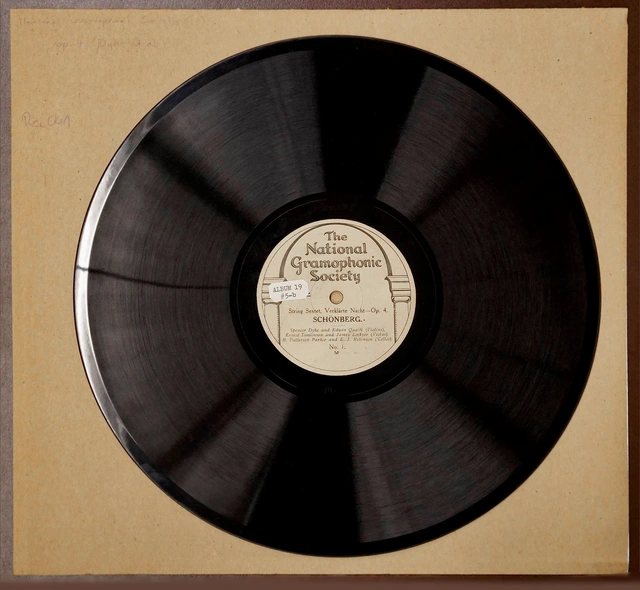 ©
©
Cover and record "Transfigured Night op. 4"
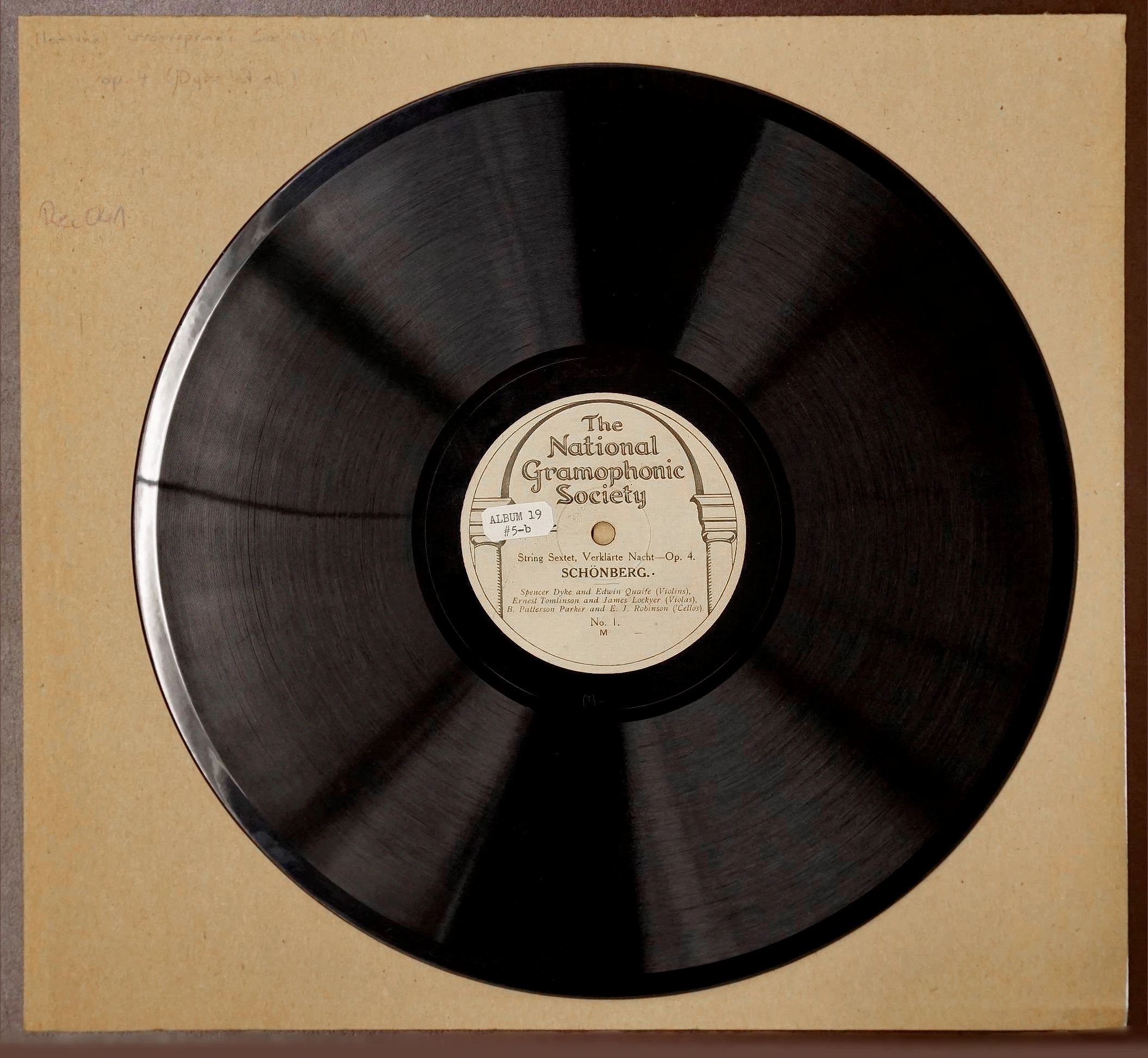
Cover and record "Transfigured Night op. 4"
With kind approval: Arnold Schönberg Center
“Is there nobody in [the recording] industry who knows that it might be of some value for this industry to have at least some of my works in an authentic recording. Is there nobody who foresees that our successors will ask how it was possible at a time where the technique was advanced enough to preserve the original doings of the most unimportant people for eternity, but was there nobody who knew that there is a man who will be of some interest in the future, but this man remained in the dark […]?”
Arnold Schönberg to Columbia Phonograph Company, December 19, 1936
Nevertheless, Schönberg recognized the potential of these discs at a very early stage. While planning pedagogical projects, the composer recommended recordings as an aid to studying, for example in order to learn orchestration using the classical masters as an example. He also hoped to achieve wider communication of his own works. For the recording of Pierrot lunaire that was released by the prestigious label Columbia – the only published commercial production under Schönberg’s direction – he even suggested that a score of the work should be included with the discs, with the aim of enabling listeners to examine the work more closely.
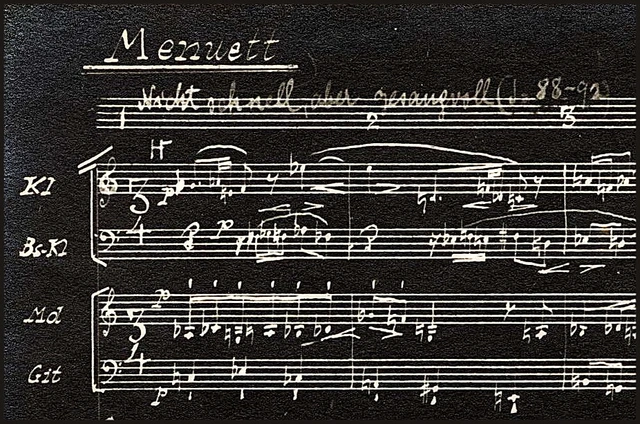 ©
©
Score "Serenade op. 24. Menuett“
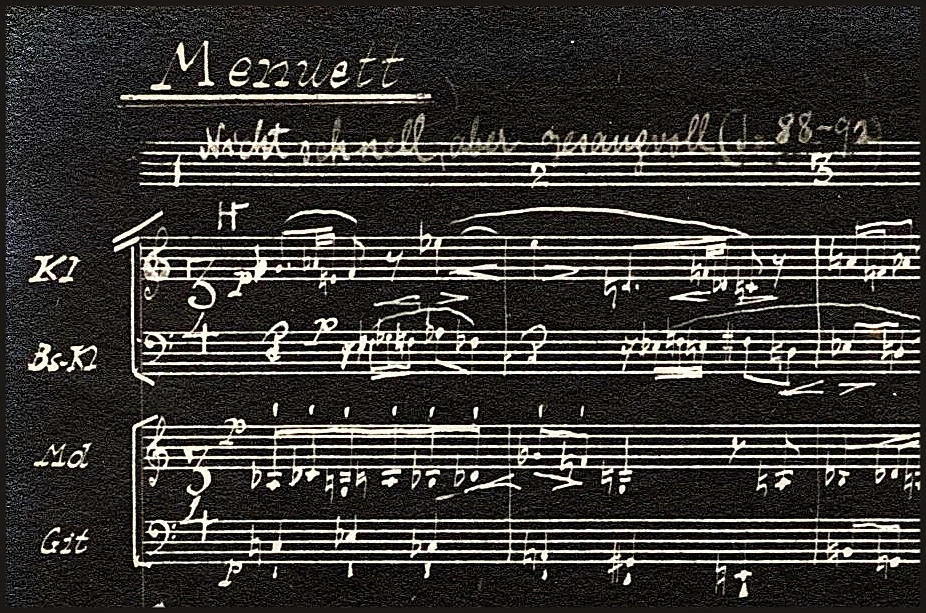
Score "Serenade op. 24. Menuett“
With kind approval: Arnold Schönberg Center
Early sound storage media from Schönberg’s collection often contain test recordings for radio broadcasts and only excerpts of the compositions played. In the USA radio broadcasts of Schönberg’s works were occasionally recorded using microphones placed on the radio itself. Even though the quality of the recording seldom lived up to the technical standards of the day, these discs are important sources for reproduction aesthetics – especially when the pieces were played by performers who had a closer relationship with the composer.
In addition to the recording of Arnold Schönberg’s entire string quartets by the Kolisch Quartet, which was already widely known, they also include early radio performances with excerpts from the Chamber Symphony, op. 9 and the Serenade, op. 24 conducted by Fritz Stiedry. These productions give an idea of the performance theory in the Viennese School, whose flexible style of performance serves to illuminate compositional structures and therefore the understanding of a work.
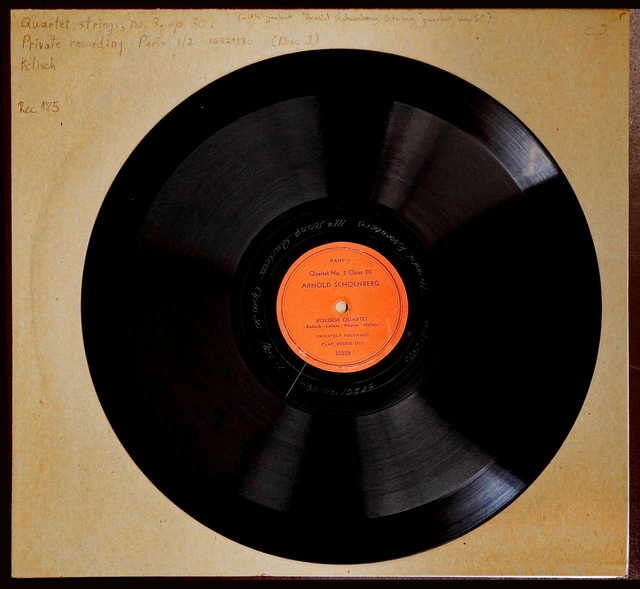 ©
©
Cover and record "String Quartet No. 3 op. 30" (Kolisch Quartet), private recording
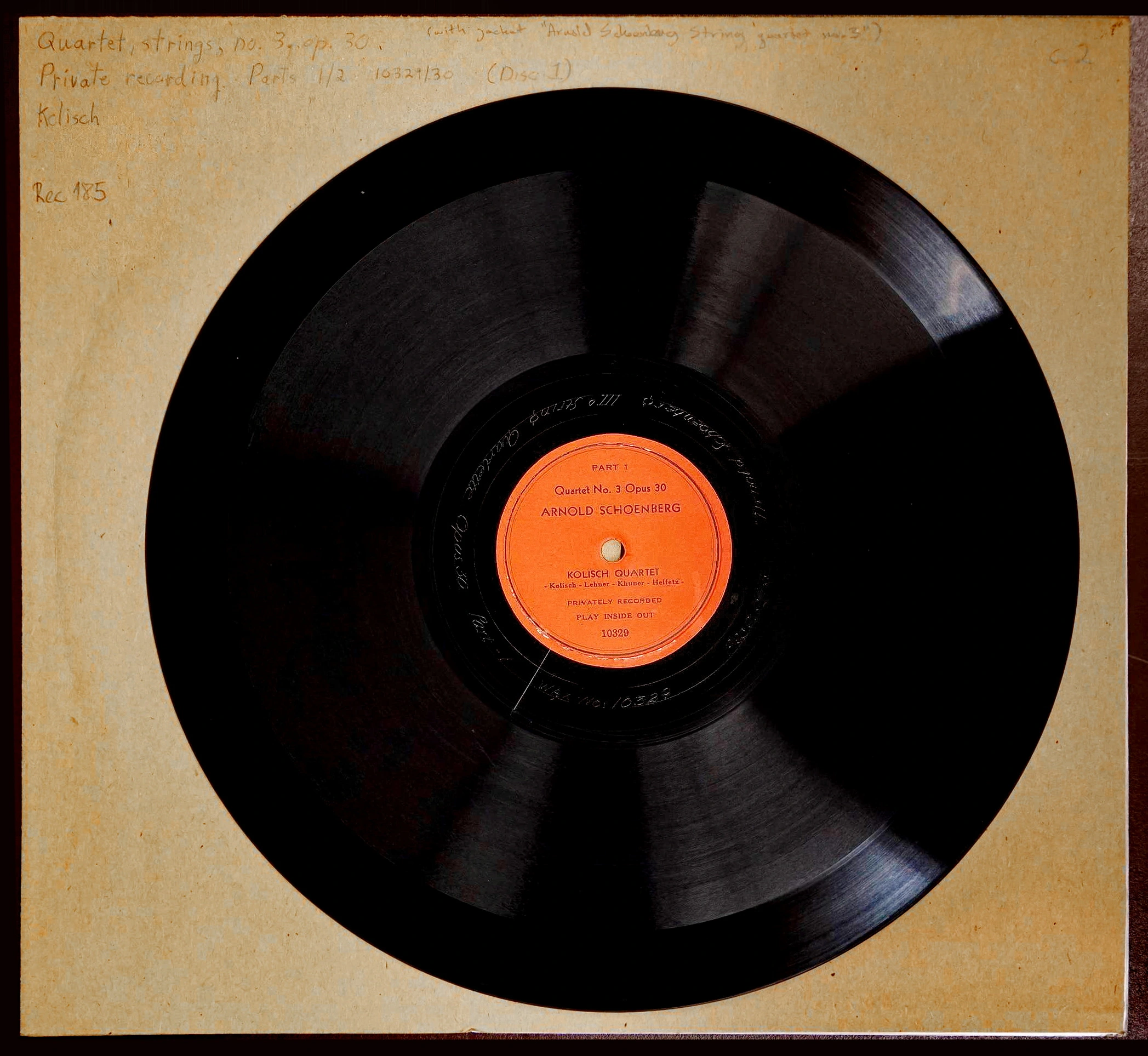
Cover and record "String Quartet No. 3 op. 30" (Kolisch Quartet), private recording
With kind approval: Arnold Schönberg Center
Beyond its musical significance, the Estate testifies to Schönberg’s transatlantic biography. The earliest audio documents stem from the composer’s time spent in Berlin and his increasing commitment to the radio, whose potential for broadcasting contemporary music to a larger audience was recognized by Schönberg at a very early stage.
“For the true product of the mind, the musical idea, the unalterable, is established in the relationship between pitches and time-divisions. But all the other things – dynamics, tempo, timbre and the character, clarity, effect, etc., which they produce – are really no more than the performer’s resources, serving to make the idea comprehensible and admitting of variations.”
Arnold Schönberg: Mechanical Musical Instruments, 1924
Despite his criticism, Schönberg was open to technical innovations and used sound recording media in various ways. While in exile in the USA, he made voice recordings of greetings together with his wife Gertrud and daughter Nuria. These recordings were to be sent as self-cut discs to Schönberg’s mother-in-law Henriette Kolisch who still lived in Vienna at the time. In his final years, Schönberg used wire coils to dictate letters and works of music theory for transcription by his assistants. And after the war, phonograph discs were an important means of communication with the Old World. The composer received several audio documents from Europe with recordings of its revived concert life, which gave him hope that his works would live on even without his direct influence.
 ©
©
Handwritten cover “Ronny”

Handwritten cover “Ronny”
With kind approval: Arnold Schönberg Center
Vienna, as the city of Schönberg’s birth and also the birthplace and namesake of the Viennese School, was chosen: in early 1997, the Arnold Schönberg Center Privatstiftung was founded by the City of Vienna together with the Internationale Schönberg Gesellschaft. After the collection had been moved from Los Angeles and the Arnold Schönberg Center had been opened in March 1998, the archive was made available to researchers, composers, musicians and the general public for scholarly research and studies.
In 2011 Schönberg’s Estate was inscribed onto the UNESCO Memory of the World Register.
In cooperation with the Arnold Schönberg Center, the Österreichische Mediathek took over the composer's record collection for digitization and digital long-term preservation in April 2019.
Arnold Schönberg’s Estate remained in the possession of his heirs after his death in 1951 and was administered by his widow Gertrud Schoenberg until 1967. In the 70s, Schönberg’s heirs decided to make the collection available to the Arnold Schoenberg Institute of the University of Southern California in Los Angeles which was founded in 1973, where a modern archive was established along with a concert hall and an exhibition hall. That archive was open to the public until 1997.
Towards the end of this period, the University of Southern California felt it could no longer fulfill the condition of Schönberg’s heirs that the Institute and archive be limited exclusively to research and studies about Arnold Schönberg, triggering a legal battle between them and the University in 1996. Many cities, universities and private individuals were interested in giving the orphaned collection a new home: New York, Vienna, Berlin, The Hague, Basel, Yale, Stanford, Harvard, Arizona and even in Los Angeles, the Getty Center and the University of California.
“For somebody who moved home so frequently, this may be his homeland. He brought all this with him.”
(Nuria Schoenberg Nono. Documentary feature: “Arnold Schönberg – Ein Wiener kehrt heim”. Vienna 1998)
(Text: Arnold Schönberg Center)
Literature
Dörte Schmidt: Schönberg und die Schallplatte oder: Über die technische Reproduzierbarkeit der Musik und das Exil, in: Ereignis und Exegese. Musikalische Interpretation - Interpretation der Musik. Festschrift Hermann Danuser zum 65. Geburtstag. Hrsg. von Camilla Borg et al. Schliengen 2011, 518-599.
Therese Muxeneder: Ethik des Bewahrens. Exil und Rückkehr des Schönberg-Nachlasses, in: Kulturelle Räume und ästhetische Universalität. Musik und Musiker im Exil. Herausgegeben von Claus-Dieter Krohn et al. München 2008, 44-66.
Markus Grassl, Reinhard Kapp (Hrsg.): Die Lehre von der musikalischen Aufführung in der Wiener Schule. Verhandlungen des Internationalen Collegiums Wien 1995. Wien, Köln, Weimar 2002 (Wiener Veröffentlichungen zu Musikgeschichte 3).




